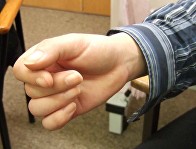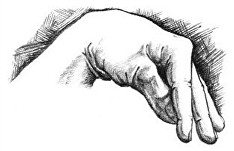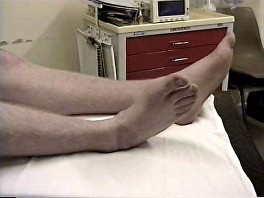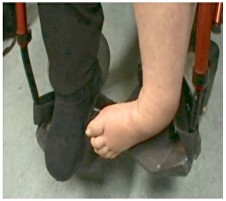Patients with functional dystonia either have ‘curled fingers’ or a ‘clenched hand’.
The other common problem in functional dystonia is that the ankle turns in and may point down,
These abnormal postures may be hard or even impossible for the patient to change which is why they are sometimes called ‘fixed dystonia’.
The pictures below show how ‘fixed’ these postures can become.
This may be a temporary intermittent problem (a spasm) or may be more chronic (this is usually called fixed / functional dystonia).




Everyone has a ‘map’ of their body and their limbs in their brain.
In broad terms what seems to be wrong in functional dystonia is that this ‘map’ in the brain, for various reasons, has gone wrong. The brain thinks that the ‘curled’ hand or ‘twisted ankle’ position is normal even though you know that it is not.
It seems that physical injuries, weakness in the limb and immobility can all be things that can distort the map in the brain.
The challenge of treatment is to try to ‘retrain the brain’ so that it can learn what the “normal map” of the limb should be.
The video below shows someone with functional ankle dystonia being asked to close their eyes and describe the position of their foot. With their eyes closed it feels like it’s in the normal position even though with their eyes open they can see that it definitely is not. This provides some evidence that the brain’s map has gone wrong. Trying to straighten the foot gives the brain the message that its being twisted outwards.
There is an overlap here with a condition called Complex Regional Pain Syndrome (CRPS). You can read about that on a separate page.
In CRPS patients develop pain in a limb that doesn’t go away or even gets worse long after the injury has healed. Functional dystonia is one of the complications of CRPS.
Pain is common in patients with functional dystonia. But you can have functional dystonia without pain as well.
The diagnosis of functional dystonia should be made by a doctor who is familiar with the different causes of dystonia.
Functional dystonia often begins quite suddenly but may be gradual. It may occur in one of the following situations:
The development of a new-onset dystonia in an adult that looks like the pictures above, particularly if it is associated with other functional neurological symptoms and especially if it came on relatively suddenly would all be strongly suggestive of functional dystonia.
Dystonia is a neurological term for abnormal and persistent muscle contraction causing a change in posture.
There are many forms of dystonia including writers cramp, cervical dystonia (sometimes called torticollis) and generalised dystonia. Dystonia can also occur in a myriad of other neurological conditions.
Some of these types of dystonia, such as Writer’s cramp, arent associated with brain disease so why aren’t they classified as functional disorders as well?
Perhaps the first thing to point out is that functional disorders are genuine and do involve the brain going wrong.
But functional disorders are characterised by their potential for reversibility. So functional dystonia, even when apparently fixed can sometimes improve under hypnosis, or with physiotherapy, whereas these other forms of dystonia rarely respond to those kinds of treatment.
In addition, patients with Writer’s cramp don’t tend to have the other functional symptoms and disorders described on this site, whereas patients with functional dystonia typically do.
There is no denying though, that functional dystonia is a good example of how it’s difficult and perhaps even false to divide problems up between those where there is a ‘disease’ and those where there is not.
Have a look through the pages on treatment on this website
Do you have confidence in the diagnosis?
It is essential that you feel that you have the correct diagnosis. If you don’t it will be hard to put into practice the rehabilitation techniques suggested here.
If you don’t feel that you have functional dystonia you need to look at what basis the diagnosis has been made. You should have some of the clinical features described above. If you do, why don’t you have confidence in the diagnosis you have been given?
You do not need to be stressed to have functional dystonia. In fact, functional dystonia is often most noticeable when people are relaxed or not thinking about anything in particular. Perhaps you rejected the diagnosis because the doctor suggested it was “stress-related”? – there may have been a misunderstanding if that was the case. We know that many patients with functional dystonia do have stress as a cause of their symptoms, but many don’t. So whether you have been stressed or not is not relevant to the diagnosis.
Specific physiotherapy techniques
We are still learning what specific techniques are most helpful for functional dystonia.
As a general principle, trying to move the affected part is really important, although if it is fixed this may not be possible.
Some of the following may be helpful.
Look on the treatment pages to find out more about specific treatments that may be relevant to you.


We will be re-directing you to the University of Edinburgh’s donate page, which enable donations in a secure manner on our behalf. We use donations for keeping the site running and further FND research.
